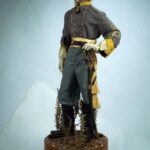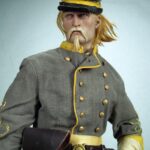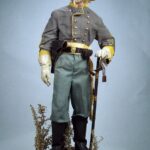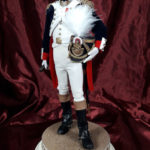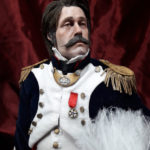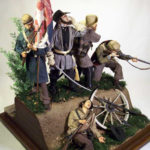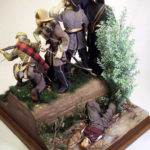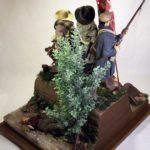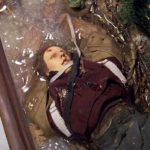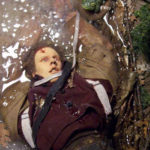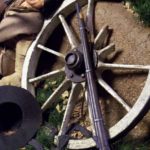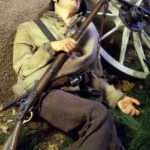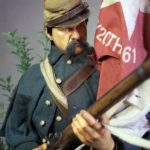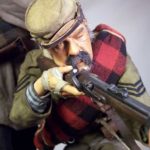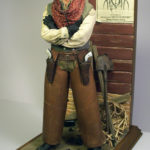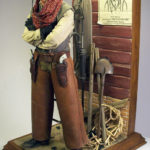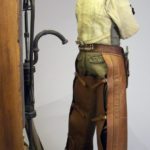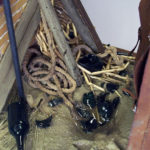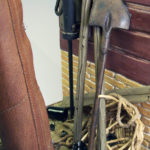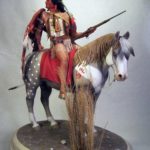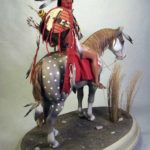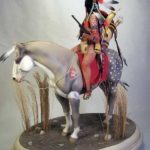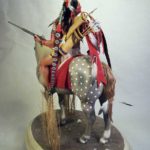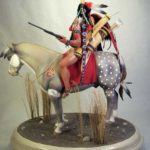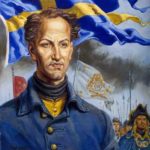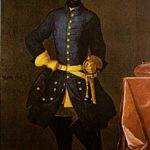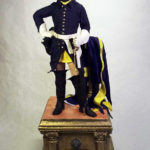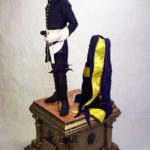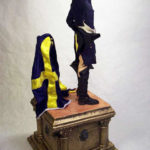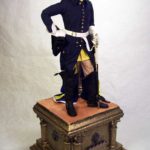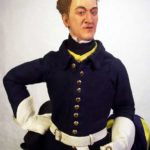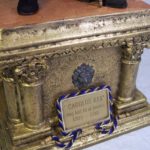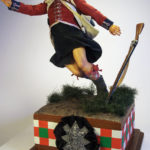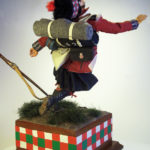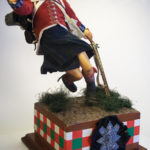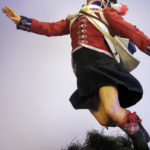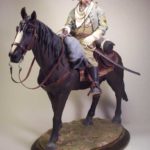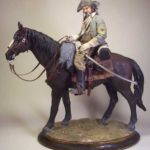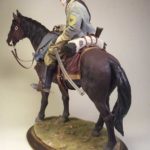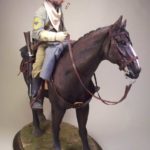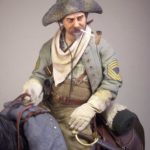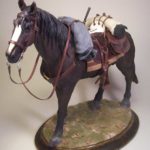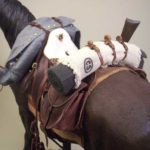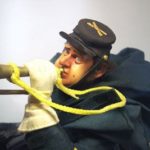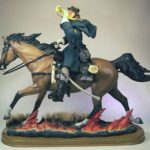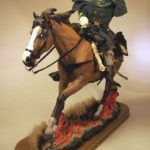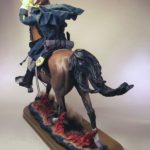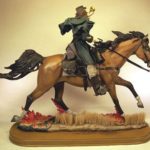“The river” – Confederate last stand
Inspired by the Masterpiece “Gettysburg, 20th Maine Little Round Top” by the great Master Bill Horan.
The notorious “Dutch Henry”
Henry Borne, more often called “Dutch Henry” was an outlaw and one of the most prevalent horse thieves and cattle rustlers of the Old West.
Mounted Lakota Warrior
The Lakota people (pronounced [laˈkˣota]; also known as Teton, Titunwan (“prairie dwellers”), Teton Sioux (“snake, or enemy”) are an indigenous people of the Great Plains of North America. They are part of a confederation of seven related Sioux tribes, the Očhéthi Šakówiŋ or seven council fires, and speak Lakota, one of the three major dialects of the Sioux language. Their population was drastically reduced after the European invasion of North America.
The Lakota are the westernmost of the three Siouan language groups, occupying lands in both North and South Dakota. The seven bands or “sub-tribes” of the Lakota are:
- Sičháŋǧu (Brulé, Burned Thighs)
- Oglála (“They Scatter Their Own”)
- Itázipčho (Sans Arc, Without Bows)
- Húŋkpapȟa (“End Village”, Camps at the End of the Camp Circle)
- Mnikȟówožu (“Plant beside the Stream”,Planters by the Water)
- Sihásapa (“Black Feet”)
- Oóhenuŋpa (Two Kettles)
Notable persons include Tȟatȟáŋka Íyotake (Sitting Bull) from the Húnkpapȟa band; Touch the Clouds from the Miniconjou band; and, Tȟašúŋke Witkó (Crazy Horse), Maȟpíya Lúta (Red Cloud), Heȟáka Sápa (Black Elk), Siŋté Glešká (Spotted Tail), and Billy Mills from the Oglala band.
On display at the Suncoast Center For Fine Scale Modeling (FLA)
“Karolus Rex” King Karl XII of Sweden (1682 – 1718)
Charles XII also Carl of Sweden, Swedish: Karl XII, Latinized to Carolus Rex (‘Charles the King’) (17 June 1682 – 30 November 1718) was the King of Sweden from 1697 to 1718. Charles was the only surviving son of King Charles XI of Sweden and Ulrika Eleonora the Elder. He assumed power, after a seven-month caretaker government, at the age of fifteen.
In 1700, a triple alliance of Denmark–Norway, Saxony–Poland–Lithuania and Russia launched a threefold attack on the Swedish protectorate of Swedish Holstein-Gottorp and provinces of Livonia and Ingria, aiming to draw advantage as Sweden was unaligned and ruled by a young and inexperienced king, thus initiating the Great Northern War. Leading the formidable Swedish army against the alliance, Charles had by 1706 forced to submission all of his foes except Russia.
Charles’ subsequent march on Moscow ended with the dismemberment of the Swedish army at Poltava and Perevolochna, and he spent the following years in exile in the Ottoman Empire before returning to lead an assault on Norway, trying to evict the Danish king from the war once more in order to aim all his forces at the Russians. Two failed campaigns concluded with his death at the Siege of Fredriksten in 1718. At the time, most of the Swedish Empire was under foreign military occupation, though Sweden itself was still free. This situation was later formalized, albeit moderated in the subsequent Treaty of Nystad. The close would see not only the end of the Swedish Empire but also of its effectively organized absolute monarchy and war machine, commencing a parliamentarian government unique for continental Europe, which would last for half a century until royal autocracy was restored by Gustav III.
Charles was an exceptionally skilled military leader and tactician as well as an able politician, credited with introducing important tax and legal reforms. As for his famous reluctance towards peace efforts he is quoted by Voltaire as saying, upon the outbreak of the war; “I have resolved never to start an unjust war but never to end a legitimate one except by defeating my enemies.” With the war consuming more than half his life and nearly all his reign, he never married and fathered no children, and was succeeded by his sister Ulrika Eleonora, who in turn was coerced to hand over all substantial powers to the Riksdag of the Estates and opted to surrender the throne to her husband, who became King Frederick I of Sweden. (Font Wikipedia)
“Fallen at Quatre Bras” – The 42nd (Royal Highland) Regiment of Foot at Wateloo – June 16, 1815
The 42nd (Royal Highland) Regiment of Foot was a Scottish infantry regiment in the British Army also known as the Black Watch. Originally titled Crawford’s Highlanders or The Highland Regiment and numbered 43rd in the line, in 1748, on the disbanding of Oglethorpe’s Regiment of Foot, they were renumbered 42nd and in 1751 formally titled the 42nd (Highland) Regiment of Foot. In 1881 the regiment was named The Royal Highland Regiment (The Black Watch), being officially redesignated The Black Watch (Royal Highland Regiment) in 1931. In 2006 the Black Watch became part of the Royal Regiment of Scotland.
The 42nd Btl fought at the chaotic Battle of Quatre Bras on 16 June 1815 under Lieutenant-colonel Sir Robert Macara, who was killed by French lancers. The 42nd was one of four battalions mentioned by Wellington in despatches after the battle. Two days later at the Battle of Waterloo, the 42nd and also the 2nd/73rd Highlanders, which was later to become the new 2nd Battalion, Black Watch, were both in some of the most intense fighting in the battle (Font Wipedia).
Union Bugler – Battle at Cedar Creek
The Battle of Cedar Creek, or Battle of Belle Grove, fought October 19, 1864, was the culminating battle of the Valley Campaigns of 1864 during the American Civil War. Confederate Lt. Gen. Jubal Early launched a surprise attack against the encamped army of Union Maj. Gen. Philip Sheridan, across Cedar Creek, northeast of Strasburg, Virginia. During the morning fighting, seven Union infantry divisions were forced to fall back and lost numerous prisoners and cannons. Early failed to continue his attack north of Middletown, and Sheridan, dramatically riding to the battlefield from Winchester, was able to rally his troops to hold a new defensive line. A Union counterattack that afternoon routed Early’s army.
At the conclusion of this battle, the final Confederate invasion of the North was effectively ended. The Confederacy was never again able to threaten Washington, D.C., through the Shenandoah Valley, nor protect one of its key economic bases in Virginia. The stunning Union victory aided the reelection of Abraham Lincoln and Sheridan won lasting fame (font Wikipedia).
